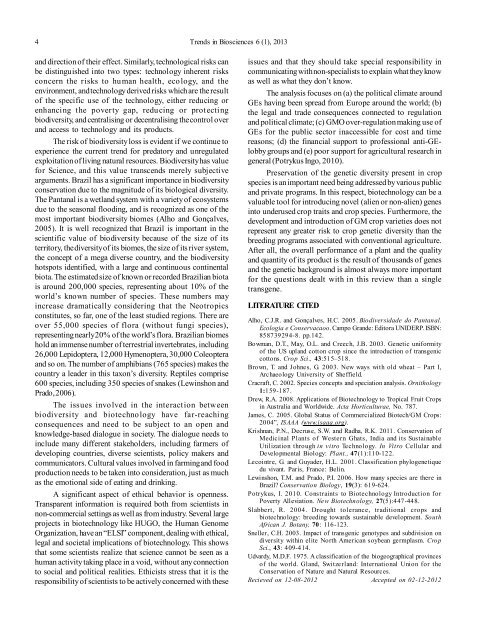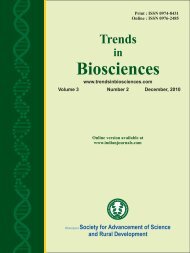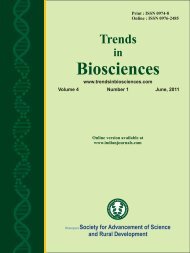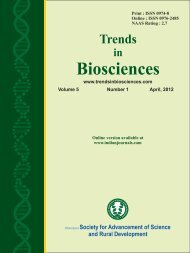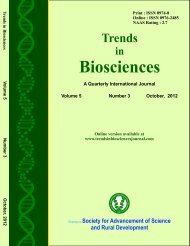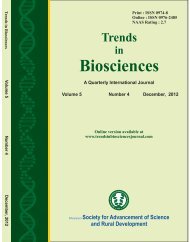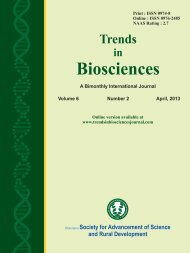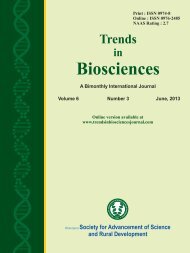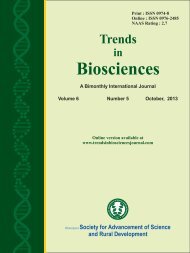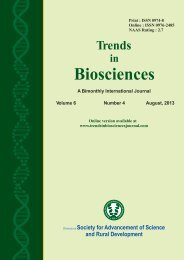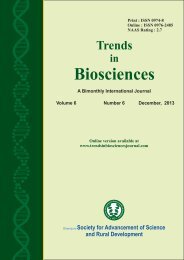TRENDS IN BIOSCIENCES 6-1, 2013 EDITION
CALL FOR RESEARCH PAPERS
CALL FOR RESEARCH PAPERS
Create successful ePaper yourself
Turn your PDF publications into a flip-book with our unique Google optimized e-Paper software.
4 Trends in Biosciences 6 (1), <strong>2013</strong><br />
and direction of their effect. Similarly, technological risks can<br />
be distinguished into two types: technology inherent risks<br />
concern the risks to human health, ecology, and the<br />
environment, and technology derived risks which are the result<br />
of the specific use of the technology, either reducing or<br />
enhancing the poverty gap, reducing or protecting<br />
biodiversity, and centralising or decentralising the control over<br />
and access to technology and its products.<br />
The risk of biodiversity loss is evident if we continue to<br />
experience the current trend for predatory and unregulated<br />
exploitation of living natural resources. Biodiversity has value<br />
for Science, and this value transcends merely subjective<br />
arguments. Brazil has a significant importance in biodiversity<br />
conservation due to the magnitude of its biological diversity.<br />
The Pantanal is a wetland system with a variety of ecosystems<br />
due to the seasonal flooding, and is recognized as one of the<br />
most important biodiversity biomes (Alho and Gonçalves,<br />
2005). It is well recognized that Brazil is important in the<br />
scientific value of biodiversity because of the size of its<br />
territory, the diversity of its biomes, the size of its river system,<br />
the concept of a mega diverse country, and the biodiversity<br />
hotspots identified, with a large and continuous continental<br />
biota. The estimated size of known or recorded Brazilian biota<br />
is around 200,000 species, representing about 10% of the<br />
world’s known number of species. These numbers may<br />
increase dramatically considering that the Neotropics<br />
constitutes, so far, one of the least studied regions. There are<br />
over 55,000 species of flora (without fungi species),<br />
representing nearly 20% of the world’s flora. Brazilian biomes<br />
hold an immense number of terrestrial invertebrates, including<br />
26,000 Lepidoptera, 12,000 Hymenoptera, 30,000 Coleoptera<br />
and so on. The number of amphibians (765 species) makes the<br />
country a leader in this taxon’s diversity. Reptiles comprise<br />
600 species, including 350 species of snakes (Lewinshon and<br />
Prado, 2006).<br />
The issues involved in the interaction between<br />
biodiversity and biotechnology have far-reaching<br />
consequences and need to be subject to an open and<br />
knowledge-based dialogue in society. The dialogue needs to<br />
include many different stakeholders, including farmers of<br />
developing countries, diverse scientists, policy makers and<br />
communicators. Cultural values involved in farming and food<br />
production needs to be taken into consideration, just as much<br />
as the emotional side of eating and drinking.<br />
A significant aspect of ethical behavior is openness.<br />
Transparent information is required both from scientists in<br />
non-commercial settings as well as from industry. Several large<br />
projects in biotechnology like HUGO, the Human Genome<br />
Organization, have an “ELSI” component, dealing with ethical,<br />
legal and societal implications of biotechnology. This shows<br />
that some scientists realize that science cannot be seen as a<br />
human activity taking place in a void, without any connection<br />
to social and political realities. Ethicists stress that it is the<br />
responsibility of scientists to be actively concerned with these<br />
issues and that they should take special responsibility in<br />
communicating with non-specialists to explain what they know<br />
as well as what they don’t know.<br />
The analysis focuses on (a) the political climate around<br />
GEs having been spread from Europe around the world; (b)<br />
the legal and trade consequences connected to regulation<br />
and political climate; (c) GMO over-regulation making use of<br />
GEs for the public sector inaccessible for cost and time<br />
reasons; (d) the financial support to professional anti-GElobby<br />
groups and (e) poor support for agricultural research in<br />
general (Potrykus Ingo, 2010).<br />
Preservation of the genetic diversity present in crop<br />
species is an important need being addressed by various public<br />
and private programs. In this respect, biotechnology can be a<br />
valuable tool for introducing novel (alien or non-alien) genes<br />
into underused crop traits and crop species. Furthermore, the<br />
development and introduction of GM crop varieties does not<br />
represent any greater risk to crop genetic diversity than the<br />
breeding programs associated with conventional agriculture.<br />
After all, the overall performance of a plant and the quality<br />
and quantity of its product is the result of thousands of genes<br />
and the genetic background is almost always more important<br />
for the questions dealt with in this review than a single<br />
transgene.<br />
LITERATURE CITED<br />
Alho, C.J.R. and Gonçalves, H.C. 2005. Biodiversidade do Pantanal.<br />
Ecologia e Conservacaoo. Campo Grande: Editora UNIDERP. ISBN:<br />
858739294-8. pp.142.<br />
Bowman, D.T., May, O.L. and Creech, J.B. 2003. Genetic uniformity<br />
of the US upland cotton crop since the introduction of transgenic<br />
cottons. Crop Sci., 43:515–518.<br />
Brown, T. and Johnes, G. 2003. New ways with old wheat – Part I,<br />
Archaeology University of Sheffield.<br />
Cracraft, C. 2002. Species concepts and speciation analysis. Ornithology<br />
1:159-187.<br />
Drew, R.A. 2008. Applications of Biotechnology to Tropical Fruit Crops<br />
in Australia and Worldwide. Acta Horticulturae, No. 787.<br />
James, C. 2005. Global Status of Commercialized Biotech/GM Crops:<br />
2004”, ISAAA (www.isaaa.org).<br />
Krishnan, P.N., Decruse, S.W. and Radha, R.K. 2011. Conservation of<br />
Medicinal Plants of Western Ghats, India and its Sustainable<br />
Utilization through in vitro Technology. In Vitro Cellular and<br />
Developmental Biology: Plant., 47(1):110-122.<br />
Lecointre, G. and Guyader, H.L. 2001. Classification phylogenetique<br />
du vivant. Paris, France: Belin.<br />
Lewinshon, T.M. and Prado, P.I. 2006. How many species are there in<br />
Brazil? Conservation Biology, 19(3): 619-624.<br />
Potrykus, I. 2010. Constraints to Biotechnology Introduction for<br />
Poverty Alleviation. New Biotechnology, 27(5):447-448.<br />
Slabbert, R. 2004. Drought tolerance, traditional crops and<br />
biotechnology: breeding towards sustainable development. South<br />
African J. Botany, 70: 116-123.<br />
Sneller, C.H. 2003. Impact of transgenic genotypes and subdivision on<br />
diversity within elite North American soybean germplasm. Crop<br />
Sci., 43: 409-414.<br />
Udvardy, M.D.F. 1975. A classification of the biogeographical provinces<br />
of the world. Gland, Switzerland: International Union for the<br />
Conservation of Nature and Natural Resources.<br />
Recieved on 12-08-2012 Accepted on 02-12-2012


